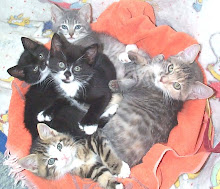 There are also instances of animal sacrifice and torture at the winter and summer solstice, but it is the Halloween holiday and the danger to cats that we will focus on for this alert.
There are also instances of animal sacrifice and torture at the winter and summer solstice, but it is the Halloween holiday and the danger to cats that we will focus on for this alert.Stray cats are an especially easy target during this time of year. Some shelters report a significant increase in requests for black cat adoptions shortly before Halloween, so much so that October is sometimes called "Black Cat Month". Consequently, many animal rescuers and adoption organizations now refuse to allow the adoption of black cats during October and some organizations do not adopt out ANY cats at all for the entire month, regardless of color.
A subtler form of cruelty can also happen during Halloween with people who want a black cat as part of their costume or as a living decorative prop for a Halloween party, haunted house, Halloween game or prank, as a scare or surprise. These cats are later returned or dropped off somewhere after the holiday is over.
Throughout history, cats have long been associated with magic, mysticism, the occult, and myths, ranging the full spectrum of human imagination. Even today, many of these old superstitions still survive. Black cats in particular, are the unfortunate recipients of a plethora of projected superstitions that cast them as an omen for bad or good, depending on where people happen to live or what they were raised to believe.
For all these reasons, if you care for or know of an animal in need of a home and are approached by a person or persons looking to adopt or foster but with whom you have even the slightest misgivings, it is best to err on the side of caution and NOT let the animal go with that person(s).
During the month of October it is also best to keep cats indoors, regardless of their color, but especially if they are black.
 Cultists and pranksters aside, just the number of strangers who are out and about on Halloween, along with extra cars, people partying and playing pranks, can make the outdoors unsafe for animals during this holiday.
Cultists and pranksters aside, just the number of strangers who are out and about on Halloween, along with extra cars, people partying and playing pranks, can make the outdoors unsafe for animals during this holiday.For additional information on Halloween safety for animals, including tips on safely decorating with the well-being of animals in mind, please see the wide range of articles on this topic and more on Humane Society's website at www.hsus.org
Safety FURst,
Big Purr



